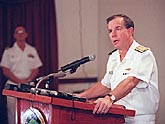 Greeneville officers to face highest-level court inquiry Greeneville officers to face highest-level court inquiry
 Civilians' names break the surface Civilians' names break the surface
 Accidents devastate military families Accidents devastate military families
 Couple extends sympathy to those involved in accident Couple extends sympathy to those involved in accident
 Incident may harm Okinawa presence Incident may harm Okinawa presence
 Chronology of tragedy at sea Chronology of tragedy at sea
 Video of the sunken Ehime Maru Video of the sunken Ehime Maru
 A Tribute to the Missing A Tribute to the Missing
 Previous stories Previous stories
 What do you think of the collision of the USS Greeneville and the Ehime Maru? Join our discussion board. What do you think of the collision of the USS Greeneville and the Ehime Maru? Join our discussion board.
By Mike Gordon
Advertiser Staff Writer
The three officers from the submarine USS Greeneville now facing a court of inquiry will be subjected to the U.S. military’s most serious investigative body, in what will amount to a public trial of those considered most responsible for the accident.
 |
| Adm. Thomas Fargo of the U.S. Pacific Fleet is directing a court of inquiry to learn all it can about the Feb. 9 incident.
Eugene Tanner • The Honolulu Advertiser |
Such courts are reserved for extraordinary events that result in multiple deaths, substantial property loss or harm to the environment where circumstances suggest a significant departure from the expected level of professionalism.
Adm. Thomas Fargo, commander of the U.S. Pacific Fleet, yesterday directed the court to learn all it could about the collision between the fast-attack submarine and the Japanese fishing vessel Ehime Maru, which sank 2,003 feet to the ocean floor about nine miles south of Diamond Head on Feb. 9.
Nine crew members remain missing.
The court of inquiry will focus on the Greeneville captain, Cmdr. Scott Waddle, the executive officer, Lt. Cmdr. Gerald K. Pfeifer, and officer of the deck Lt. j.g Michael J. Coen.
A court of inquiry is rare. Navy legal officials at Pearl Harbor say the last time one was convened was in October 1992 after the aircraft carrier USS Saratoga launched a missile attack on a Turkish destroyer in the Aegean Sea, killing five men.
In that case, however, the court of inquiry rejected a courts-martial for the crew and officers involved and instead ordered disciplinary hearings.
The Greeneville case will be heard by three admirals. They do not have the power to deliver a formal verdict but will offer findings, opinions and recommendations to Fargo.
Fargo then must decide what to do next. His options range from exoneration to referring one or all of the officers for a courts-martial, a criminal proceeding that could lead to imprisonment.
Although there is no jury, the proceedings in a court of inquiry resemble those in a civilian court room.
Each of the Greeneville officers will be provided with a military defense attorney and will be present throughout the proceedings. If they want civilian counsel, they must pay for it themselves.
The court has the power to order military witnesses to appear and subpoena civilian witnesses. Additional information that was not contained in the Navy’s preliminary inquiry also can be requested.
Witnesses testify under oath and are subject to cross examination. The parties have the right against self incrimination. And closing arguments are given.
Attorneys for the Greeneville officers also have the right to challenge the impartiality of the admirals on the court. If upheld, an officer would be excused from the court.
In the court setting, rank may not play the role it usually does. Military defense attorneys can be zealous and are ethically bound to represent their client’s interest.
The court, expected to convene Thursday, will consist of three U.S. flag officers: Vice Adm. John B. Nathman, commander of the Pacific Fleet’s naval air force; Rear Adm. Paul F. Sullivan, director for plans and policies at the U.S. Strategic Command; and Rear Adm. David M. Stone, commander of Destroyer Group 5.
[back to top] |

